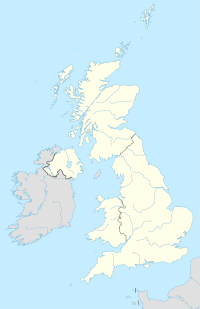Felixstowe
Coordinates: 51 ° 58 ′ N , 1 ° 21 ′ E
Felixstowe is at the mouth of the rivers Stour and Orwell in the North Sea located British port city in the region Suffolk , England . The container port of Felixstowe is the largest in the UK. With 29,349 inhabitants (as of 2001) Felixstowe is the largest city in the Suffolk Coastal district .
history
Originally there was a late Roman fort in the district of Walton Castle , which was part of the fortress chain of the late antique "litus saxonicum" ( Saxony coast ). It secured a section of the south-east coast of Britain (particularly the Deben estuary) from pirates and enemy invaders. The place was possibly a bishopric in the 7th century and existed before the Norman conquest of England in 1066. In the 11th century Roger Bigod founded a priory in Felixstowe, which was dedicated to St. Felix .
The village of Felixstowe consisted of only a few houses until the 19th century. From the second half of the 19th century, the place experienced a strong increase in population. The Felixstowe Railway and Pier Company , founded under the leadership of a local landowner, Colonel George Tomline, began in 1875 with the construction of a seaport in Felixstowe and a railway line from Ipswich / Westerfield to Felixstowe. The railway line was opened in 1877; railway operations was the much larger 1,879 railway company Great Eastern Railway transmitted. The port operator, renamed Felixstowe Dock and Railway Company in 1879, opened the port's first dock in 1886. At the same time, Felixstowe developed into a popular holiday resort, favored by a mild, dry climate and the rail link to London . In 1905, a pier was built for tourist purposes , similar to other British coastal towns. It has not been accessible to the public since the 1990s due to its poor state of construction. Tourism played an important role in Felixstowe until the late 1930s and then gradually declined. Town twinning has existed between Felixstowe and Wesel since 1972 and between Felixstowe and Salzwedel since 1994 .
During the First World War , Felixstowe was the location of a division of reconnaissance aircraft of the British naval aviation . The city of Felixstowe gave its name to a flying boat developed here .
port
The Port of Felixstowe, which opened in 1886, was expanded considerably from the 1960s onwards. A terminal for handling containers and swap bodies ("Landguard Container Terminal") was opened on July 1, 1967; this started the expansion of the port of Felixstowe into the largest container port in Great Britain. A second, larger container terminal , "Trinity Terminal", was built from 1972 onwards. Today, containers with a volume of more than three million TEU can be handled annually .
The A14 road (it leads 204 km to the M1 / M6 motorway junction ("Catthorpe Interchange") near Rugby ) and the railway line are good transport links on the land side. Three of the four British rail companies active in freight transport , EWS , Freightliner and GB Railfreight , call at the port several times a day. The entire port has been owned by CK Hutchison Holdings from Hong Kong since 1991 (75%) and 1994 (100%) .
biology
The Felixstowe area is the driest in Great Britain with just over 500mm of rainfall per year. The dunes are overgrown with moss, lichen, dill and blackberry hedges, the littoral with sea kale ( real sea kale , crambe maritima).
sons and daughters of the town
- Dawn Addams (1930–1985), actress
- James Barclay (born 1965), fantasy author
- John Bridgeman (1916-2004), sculptor
- Roy Lewis (1913-1996), writer
- John Mills (1908-2005), actor
- Pete-Anthony-Alderton (* 1955), musician
Web links
- Official website of the place Felixstowe (English)
- The port operator website (English)
Individual evidence
- ^ Richard Hoggett: The Archeology of the East Anglian Conversion (Anglo-Saxon Studies), Boydell & Brewer, 2010, ISBN 978-1843835950 , pp. 37-38.
- ↑ Felixstowe: Town History ( Memento of the original from April 16, 2015 in the Internet Archive ) Info: The archive link was inserted automatically and has not yet been checked. Please check the original and archive link according to the instructions and then remove this notice. at felixstowe.gov.uk (English)
- ↑ the railway line is called Felixstowe Branch Line in English .
- ↑ http://www.geolocation.ws/v/E/2961688/sea-kale-growing-along-the-esplanade/en Sea Kale in Felixstowe

